Implementing Corporate Governance Principles
VerifiedAdded on 2021/04/21
|10
|2134
|77
AI Summary
This assignment provides a comprehensive analysis of the corporate governance principles recommended by ASX's Corporate Governance Council. The report outlines the key aspects of these principles, including accountability, transparency, and responsible business practices. Specifically, it discusses the importance of accurate information disclosure for shareholders, as well as the company's responsibility towards society, particularly in terms of environmental impact and humanitarian considerations. The analysis concludes that implementing these principles is essential for BHL to regain its market position and maintain shareholder credibility.
Contribute Materials
Your contribution can guide someone’s learning journey. Share your
documents today.
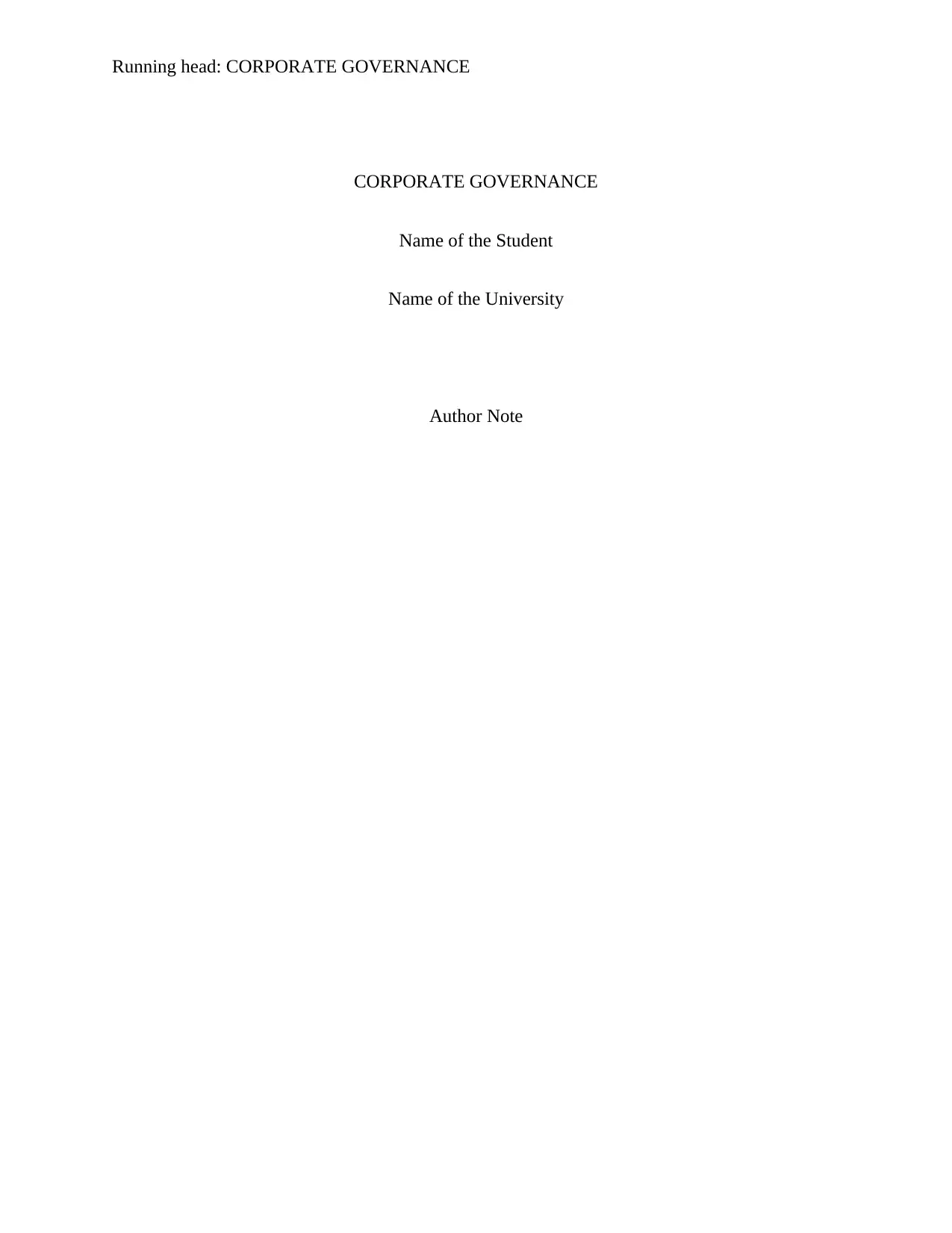
Running head: CORPORATE GOVERNANCE
CORPORATE GOVERNANCE
Name of the Student
Name of the University
Author Note
CORPORATE GOVERNANCE
Name of the Student
Name of the University
Author Note
Secure Best Marks with AI Grader
Need help grading? Try our AI Grader for instant feedback on your assignments.
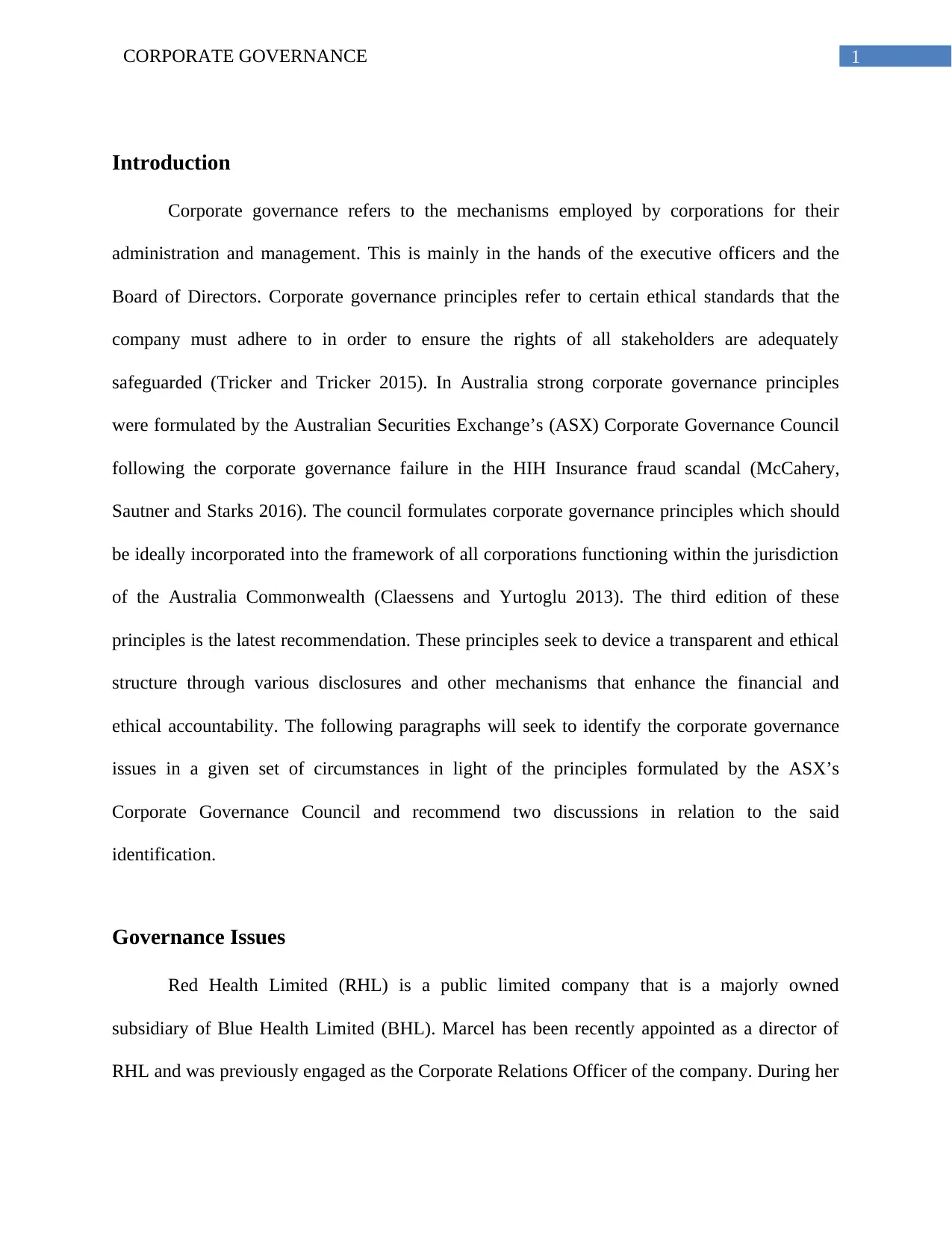
1CORPORATE GOVERNANCE
Introduction
Corporate governance refers to the mechanisms employed by corporations for their
administration and management. This is mainly in the hands of the executive officers and the
Board of Directors. Corporate governance principles refer to certain ethical standards that the
company must adhere to in order to ensure the rights of all stakeholders are adequately
safeguarded (Tricker and Tricker 2015). In Australia strong corporate governance principles
were formulated by the Australian Securities Exchange’s (ASX) Corporate Governance Council
following the corporate governance failure in the HIH Insurance fraud scandal (McCahery,
Sautner and Starks 2016). The council formulates corporate governance principles which should
be ideally incorporated into the framework of all corporations functioning within the jurisdiction
of the Australia Commonwealth (Claessens and Yurtoglu 2013). The third edition of these
principles is the latest recommendation. These principles seek to device a transparent and ethical
structure through various disclosures and other mechanisms that enhance the financial and
ethical accountability. The following paragraphs will seek to identify the corporate governance
issues in a given set of circumstances in light of the principles formulated by the ASX’s
Corporate Governance Council and recommend two discussions in relation to the said
identification.
Governance Issues
Red Health Limited (RHL) is a public limited company that is a majorly owned
subsidiary of Blue Health Limited (BHL). Marcel has been recently appointed as a director of
RHL and was previously engaged as the Corporate Relations Officer of the company. During her
Introduction
Corporate governance refers to the mechanisms employed by corporations for their
administration and management. This is mainly in the hands of the executive officers and the
Board of Directors. Corporate governance principles refer to certain ethical standards that the
company must adhere to in order to ensure the rights of all stakeholders are adequately
safeguarded (Tricker and Tricker 2015). In Australia strong corporate governance principles
were formulated by the Australian Securities Exchange’s (ASX) Corporate Governance Council
following the corporate governance failure in the HIH Insurance fraud scandal (McCahery,
Sautner and Starks 2016). The council formulates corporate governance principles which should
be ideally incorporated into the framework of all corporations functioning within the jurisdiction
of the Australia Commonwealth (Claessens and Yurtoglu 2013). The third edition of these
principles is the latest recommendation. These principles seek to device a transparent and ethical
structure through various disclosures and other mechanisms that enhance the financial and
ethical accountability. The following paragraphs will seek to identify the corporate governance
issues in a given set of circumstances in light of the principles formulated by the ASX’s
Corporate Governance Council and recommend two discussions in relation to the said
identification.
Governance Issues
Red Health Limited (RHL) is a public limited company that is a majorly owned
subsidiary of Blue Health Limited (BHL). Marcel has been recently appointed as a director of
RHL and was previously engaged as the Corporate Relations Officer of the company. During her
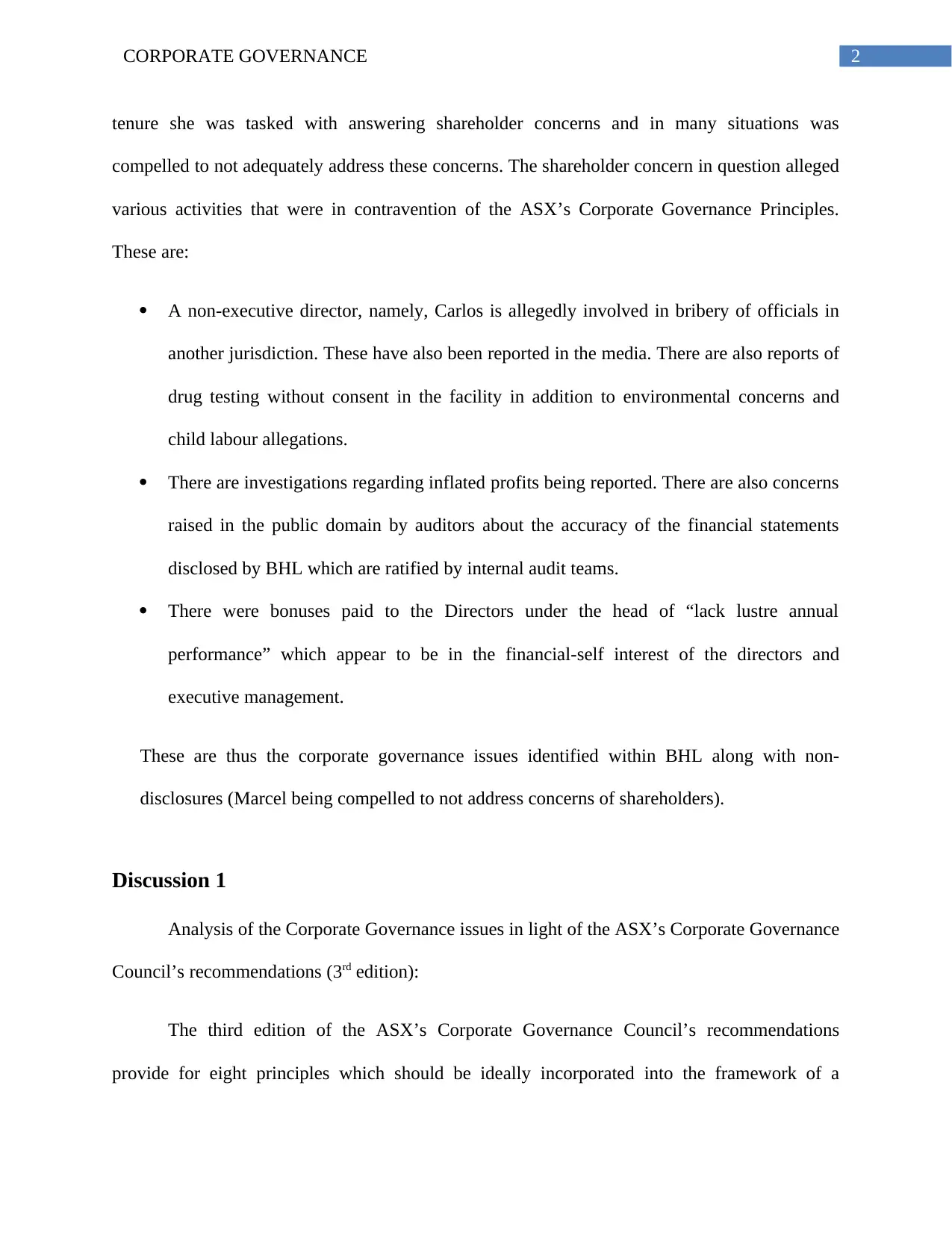
2CORPORATE GOVERNANCE
tenure she was tasked with answering shareholder concerns and in many situations was
compelled to not adequately address these concerns. The shareholder concern in question alleged
various activities that were in contravention of the ASX’s Corporate Governance Principles.
These are:
A non-executive director, namely, Carlos is allegedly involved in bribery of officials in
another jurisdiction. These have also been reported in the media. There are also reports of
drug testing without consent in the facility in addition to environmental concerns and
child labour allegations.
There are investigations regarding inflated profits being reported. There are also concerns
raised in the public domain by auditors about the accuracy of the financial statements
disclosed by BHL which are ratified by internal audit teams.
There were bonuses paid to the Directors under the head of “lack lustre annual
performance” which appear to be in the financial-self interest of the directors and
executive management.
These are thus the corporate governance issues identified within BHL along with non-
disclosures (Marcel being compelled to not address concerns of shareholders).
Discussion 1
Analysis of the Corporate Governance issues in light of the ASX’s Corporate Governance
Council’s recommendations (3rd edition):
The third edition of the ASX’s Corporate Governance Council’s recommendations
provide for eight principles which should be ideally incorporated into the framework of a
tenure she was tasked with answering shareholder concerns and in many situations was
compelled to not adequately address these concerns. The shareholder concern in question alleged
various activities that were in contravention of the ASX’s Corporate Governance Principles.
These are:
A non-executive director, namely, Carlos is allegedly involved in bribery of officials in
another jurisdiction. These have also been reported in the media. There are also reports of
drug testing without consent in the facility in addition to environmental concerns and
child labour allegations.
There are investigations regarding inflated profits being reported. There are also concerns
raised in the public domain by auditors about the accuracy of the financial statements
disclosed by BHL which are ratified by internal audit teams.
There were bonuses paid to the Directors under the head of “lack lustre annual
performance” which appear to be in the financial-self interest of the directors and
executive management.
These are thus the corporate governance issues identified within BHL along with non-
disclosures (Marcel being compelled to not address concerns of shareholders).
Discussion 1
Analysis of the Corporate Governance issues in light of the ASX’s Corporate Governance
Council’s recommendations (3rd edition):
The third edition of the ASX’s Corporate Governance Council’s recommendations
provide for eight principles which should be ideally incorporated into the framework of a
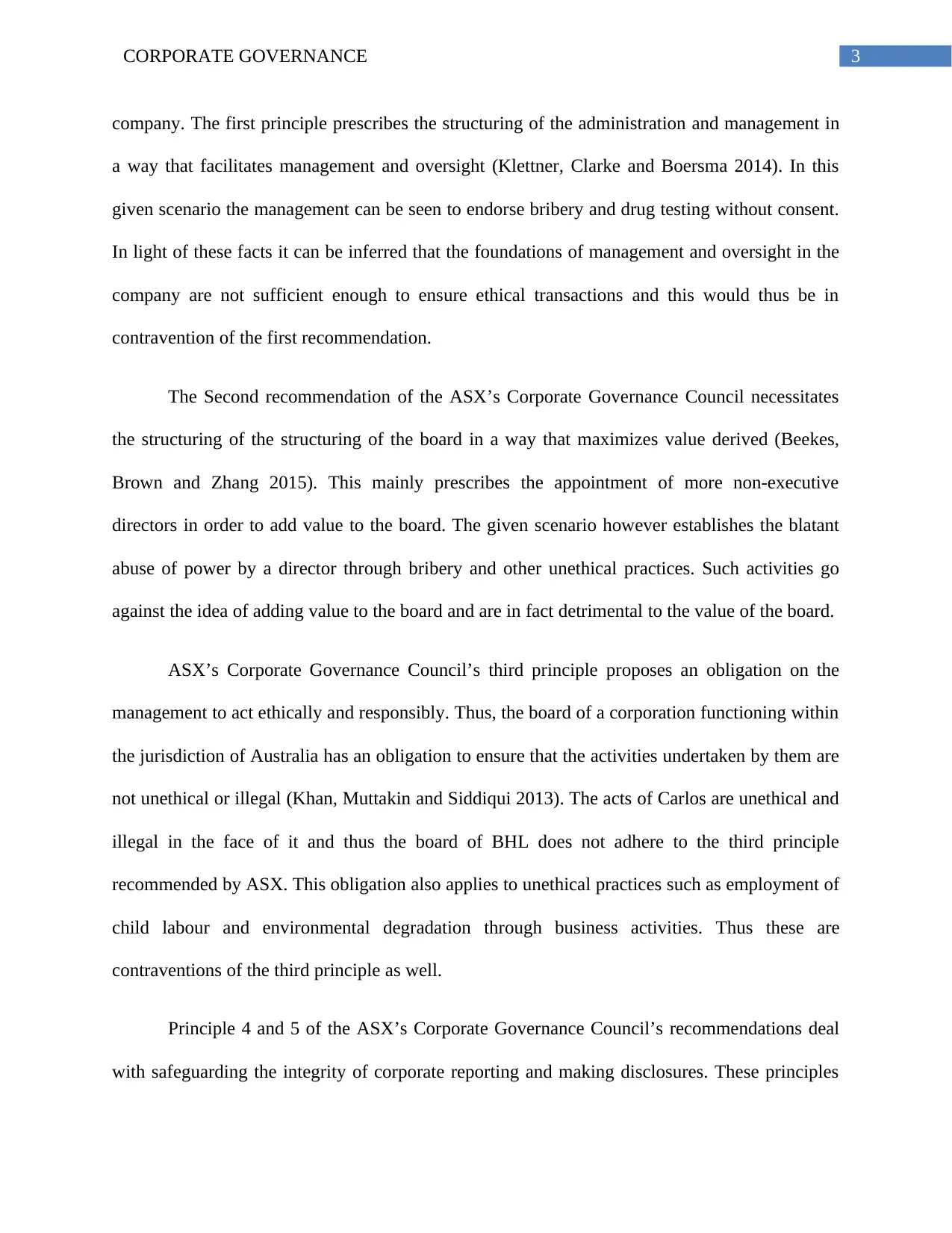
3CORPORATE GOVERNANCE
company. The first principle prescribes the structuring of the administration and management in
a way that facilitates management and oversight (Klettner, Clarke and Boersma 2014). In this
given scenario the management can be seen to endorse bribery and drug testing without consent.
In light of these facts it can be inferred that the foundations of management and oversight in the
company are not sufficient enough to ensure ethical transactions and this would thus be in
contravention of the first recommendation.
The Second recommendation of the ASX’s Corporate Governance Council necessitates
the structuring of the structuring of the board in a way that maximizes value derived (Beekes,
Brown and Zhang 2015). This mainly prescribes the appointment of more non-executive
directors in order to add value to the board. The given scenario however establishes the blatant
abuse of power by a director through bribery and other unethical practices. Such activities go
against the idea of adding value to the board and are in fact detrimental to the value of the board.
ASX’s Corporate Governance Council’s third principle proposes an obligation on the
management to act ethically and responsibly. Thus, the board of a corporation functioning within
the jurisdiction of Australia has an obligation to ensure that the activities undertaken by them are
not unethical or illegal (Khan, Muttakin and Siddiqui 2013). The acts of Carlos are unethical and
illegal in the face of it and thus the board of BHL does not adhere to the third principle
recommended by ASX. This obligation also applies to unethical practices such as employment of
child labour and environmental degradation through business activities. Thus these are
contraventions of the third principle as well.
Principle 4 and 5 of the ASX’s Corporate Governance Council’s recommendations deal
with safeguarding the integrity of corporate reporting and making disclosures. These principles
company. The first principle prescribes the structuring of the administration and management in
a way that facilitates management and oversight (Klettner, Clarke and Boersma 2014). In this
given scenario the management can be seen to endorse bribery and drug testing without consent.
In light of these facts it can be inferred that the foundations of management and oversight in the
company are not sufficient enough to ensure ethical transactions and this would thus be in
contravention of the first recommendation.
The Second recommendation of the ASX’s Corporate Governance Council necessitates
the structuring of the structuring of the board in a way that maximizes value derived (Beekes,
Brown and Zhang 2015). This mainly prescribes the appointment of more non-executive
directors in order to add value to the board. The given scenario however establishes the blatant
abuse of power by a director through bribery and other unethical practices. Such activities go
against the idea of adding value to the board and are in fact detrimental to the value of the board.
ASX’s Corporate Governance Council’s third principle proposes an obligation on the
management to act ethically and responsibly. Thus, the board of a corporation functioning within
the jurisdiction of Australia has an obligation to ensure that the activities undertaken by them are
not unethical or illegal (Khan, Muttakin and Siddiqui 2013). The acts of Carlos are unethical and
illegal in the face of it and thus the board of BHL does not adhere to the third principle
recommended by ASX. This obligation also applies to unethical practices such as employment of
child labour and environmental degradation through business activities. Thus these are
contraventions of the third principle as well.
Principle 4 and 5 of the ASX’s Corporate Governance Council’s recommendations deal
with safeguarding the integrity of corporate reporting and making disclosures. These principles
Secure Best Marks with AI Grader
Need help grading? Try our AI Grader for instant feedback on your assignments.
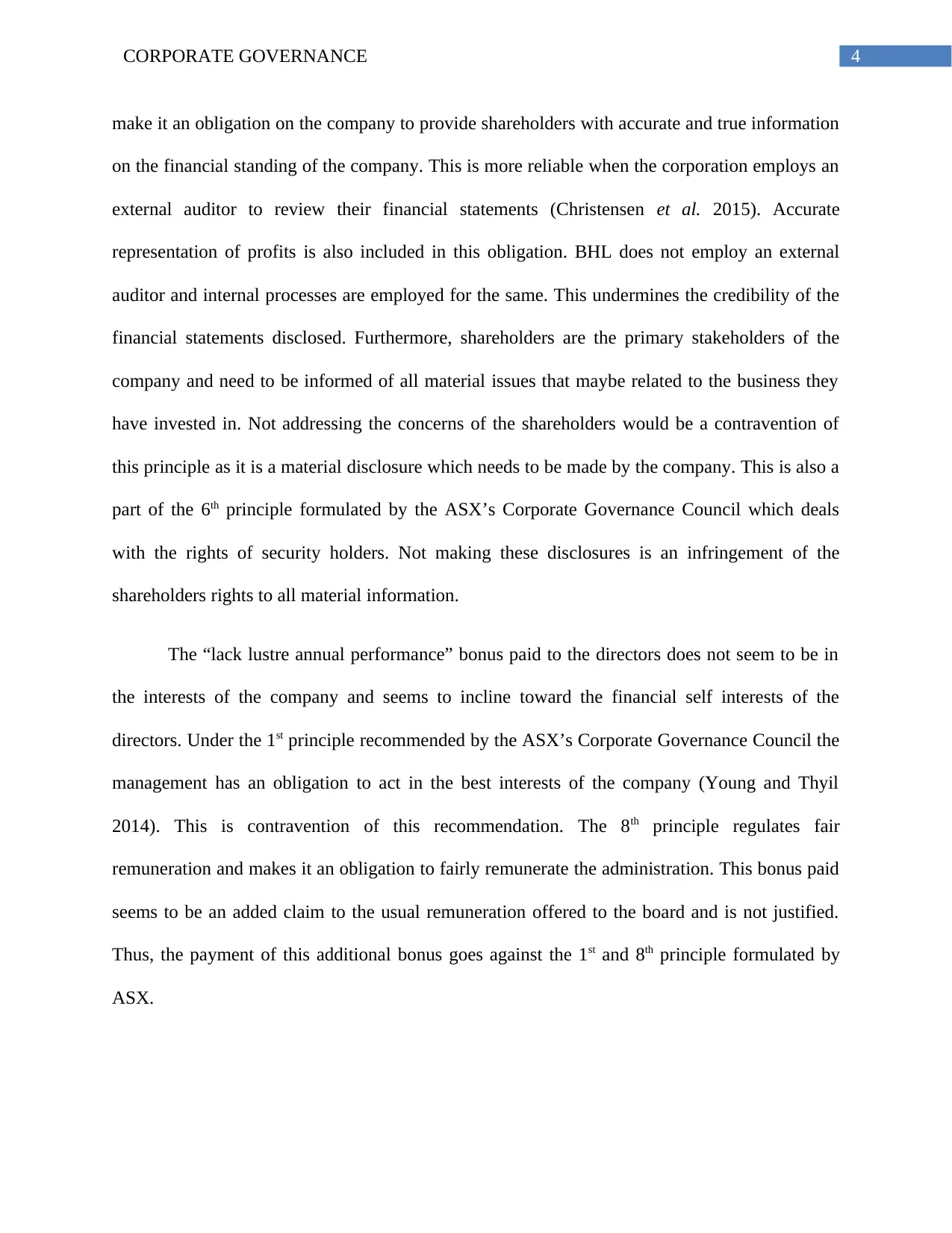
4CORPORATE GOVERNANCE
make it an obligation on the company to provide shareholders with accurate and true information
on the financial standing of the company. This is more reliable when the corporation employs an
external auditor to review their financial statements (Christensen et al. 2015). Accurate
representation of profits is also included in this obligation. BHL does not employ an external
auditor and internal processes are employed for the same. This undermines the credibility of the
financial statements disclosed. Furthermore, shareholders are the primary stakeholders of the
company and need to be informed of all material issues that maybe related to the business they
have invested in. Not addressing the concerns of the shareholders would be a contravention of
this principle as it is a material disclosure which needs to be made by the company. This is also a
part of the 6th principle formulated by the ASX’s Corporate Governance Council which deals
with the rights of security holders. Not making these disclosures is an infringement of the
shareholders rights to all material information.
The “lack lustre annual performance” bonus paid to the directors does not seem to be in
the interests of the company and seems to incline toward the financial self interests of the
directors. Under the 1st principle recommended by the ASX’s Corporate Governance Council the
management has an obligation to act in the best interests of the company (Young and Thyil
2014). This is contravention of this recommendation. The 8th principle regulates fair
remuneration and makes it an obligation to fairly remunerate the administration. This bonus paid
seems to be an added claim to the usual remuneration offered to the board and is not justified.
Thus, the payment of this additional bonus goes against the 1st and 8th principle formulated by
ASX.
make it an obligation on the company to provide shareholders with accurate and true information
on the financial standing of the company. This is more reliable when the corporation employs an
external auditor to review their financial statements (Christensen et al. 2015). Accurate
representation of profits is also included in this obligation. BHL does not employ an external
auditor and internal processes are employed for the same. This undermines the credibility of the
financial statements disclosed. Furthermore, shareholders are the primary stakeholders of the
company and need to be informed of all material issues that maybe related to the business they
have invested in. Not addressing the concerns of the shareholders would be a contravention of
this principle as it is a material disclosure which needs to be made by the company. This is also a
part of the 6th principle formulated by the ASX’s Corporate Governance Council which deals
with the rights of security holders. Not making these disclosures is an infringement of the
shareholders rights to all material information.
The “lack lustre annual performance” bonus paid to the directors does not seem to be in
the interests of the company and seems to incline toward the financial self interests of the
directors. Under the 1st principle recommended by the ASX’s Corporate Governance Council the
management has an obligation to act in the best interests of the company (Young and Thyil
2014). This is contravention of this recommendation. The 8th principle regulates fair
remuneration and makes it an obligation to fairly remunerate the administration. This bonus paid
seems to be an added claim to the usual remuneration offered to the board and is not justified.
Thus, the payment of this additional bonus goes against the 1st and 8th principle formulated by
ASX.
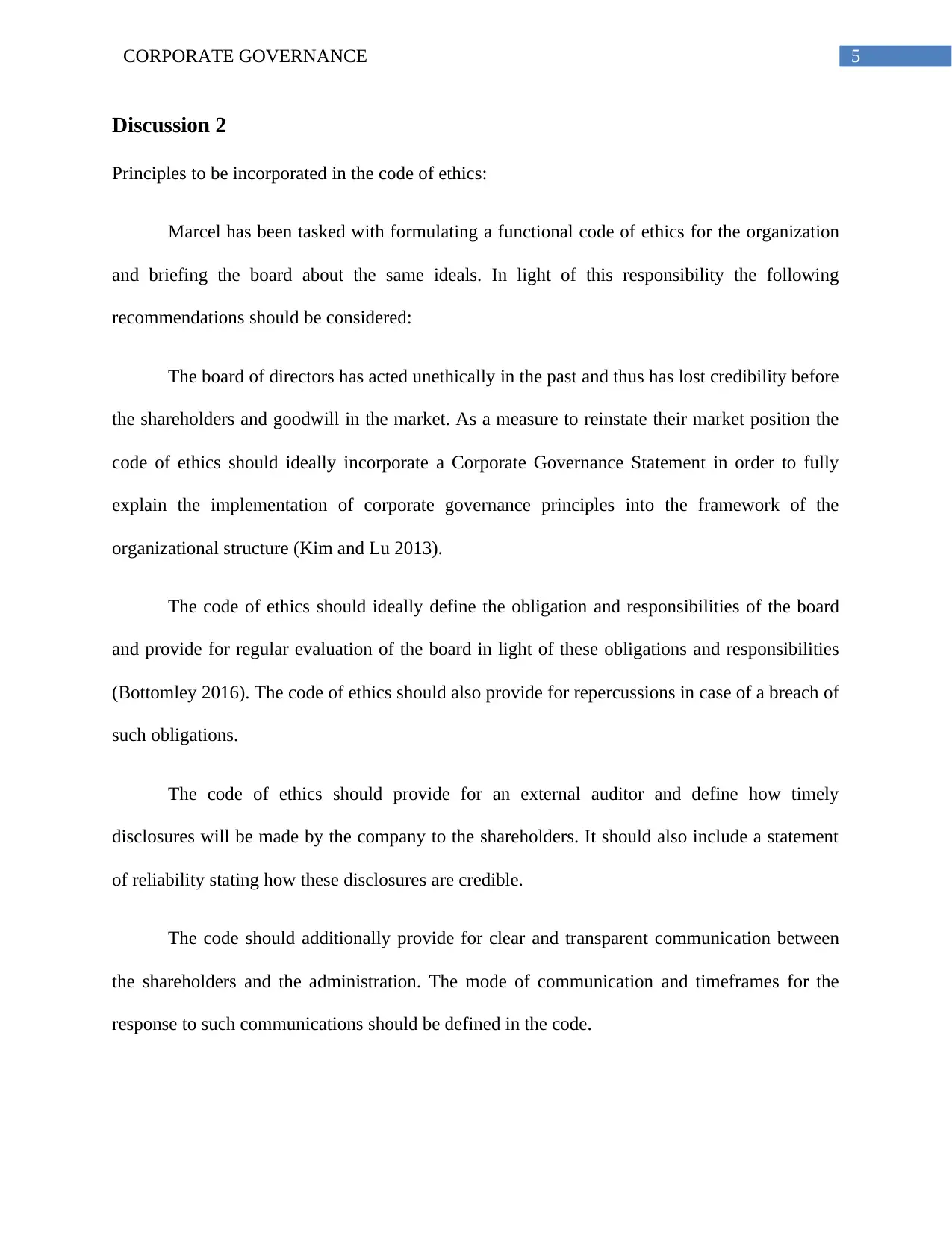
5CORPORATE GOVERNANCE
Discussion 2
Principles to be incorporated in the code of ethics:
Marcel has been tasked with formulating a functional code of ethics for the organization
and briefing the board about the same ideals. In light of this responsibility the following
recommendations should be considered:
The board of directors has acted unethically in the past and thus has lost credibility before
the shareholders and goodwill in the market. As a measure to reinstate their market position the
code of ethics should ideally incorporate a Corporate Governance Statement in order to fully
explain the implementation of corporate governance principles into the framework of the
organizational structure (Kim and Lu 2013).
The code of ethics should ideally define the obligation and responsibilities of the board
and provide for regular evaluation of the board in light of these obligations and responsibilities
(Bottomley 2016). The code of ethics should also provide for repercussions in case of a breach of
such obligations.
The code of ethics should provide for an external auditor and define how timely
disclosures will be made by the company to the shareholders. It should also include a statement
of reliability stating how these disclosures are credible.
The code should additionally provide for clear and transparent communication between
the shareholders and the administration. The mode of communication and timeframes for the
response to such communications should be defined in the code.
Discussion 2
Principles to be incorporated in the code of ethics:
Marcel has been tasked with formulating a functional code of ethics for the organization
and briefing the board about the same ideals. In light of this responsibility the following
recommendations should be considered:
The board of directors has acted unethically in the past and thus has lost credibility before
the shareholders and goodwill in the market. As a measure to reinstate their market position the
code of ethics should ideally incorporate a Corporate Governance Statement in order to fully
explain the implementation of corporate governance principles into the framework of the
organizational structure (Kim and Lu 2013).
The code of ethics should ideally define the obligation and responsibilities of the board
and provide for regular evaluation of the board in light of these obligations and responsibilities
(Bottomley 2016). The code of ethics should also provide for repercussions in case of a breach of
such obligations.
The code of ethics should provide for an external auditor and define how timely
disclosures will be made by the company to the shareholders. It should also include a statement
of reliability stating how these disclosures are credible.
The code should additionally provide for clear and transparent communication between
the shareholders and the administration. The mode of communication and timeframes for the
response to such communications should be defined in the code.
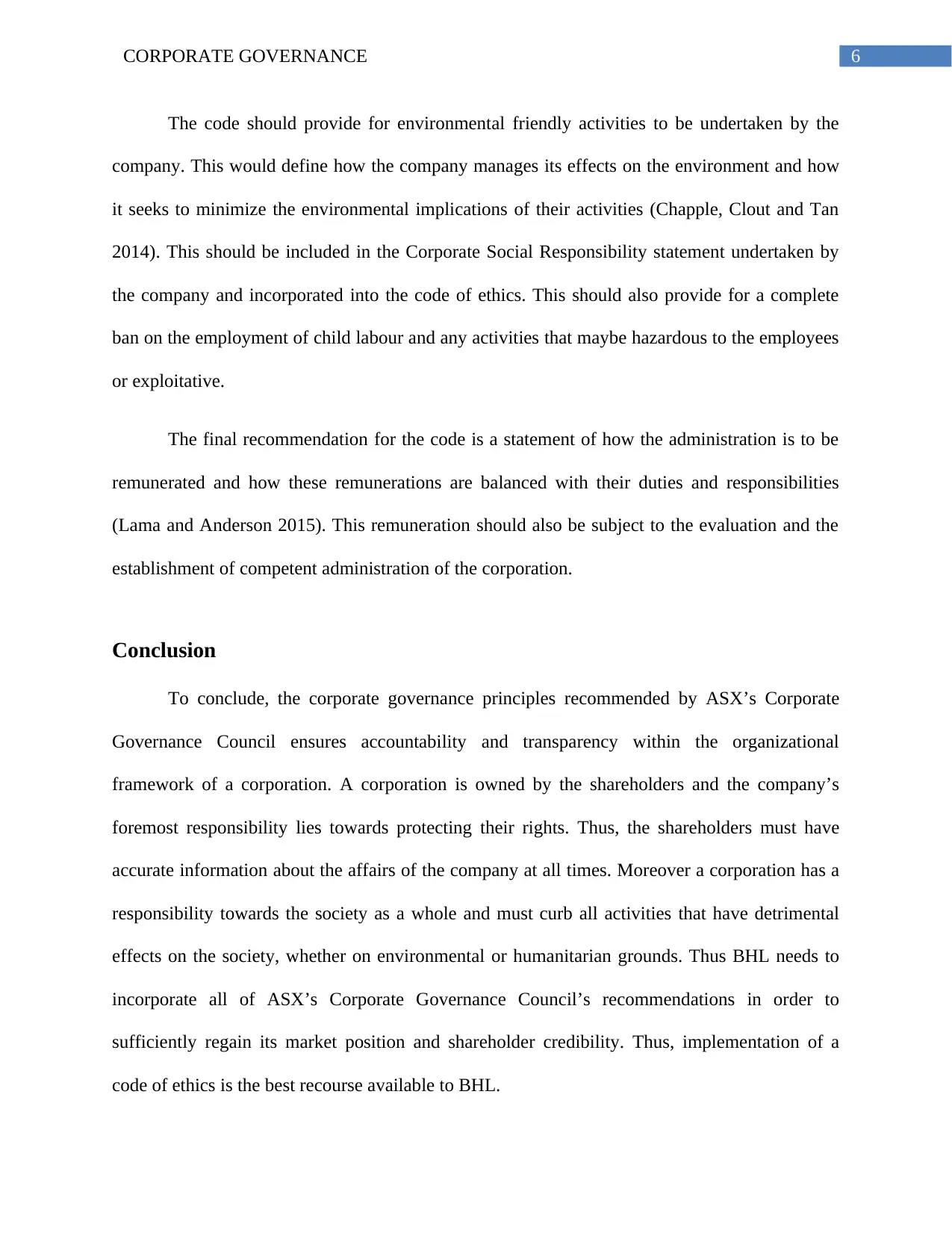
6CORPORATE GOVERNANCE
The code should provide for environmental friendly activities to be undertaken by the
company. This would define how the company manages its effects on the environment and how
it seeks to minimize the environmental implications of their activities (Chapple, Clout and Tan
2014). This should be included in the Corporate Social Responsibility statement undertaken by
the company and incorporated into the code of ethics. This should also provide for a complete
ban on the employment of child labour and any activities that maybe hazardous to the employees
or exploitative.
The final recommendation for the code is a statement of how the administration is to be
remunerated and how these remunerations are balanced with their duties and responsibilities
(Lama and Anderson 2015). This remuneration should also be subject to the evaluation and the
establishment of competent administration of the corporation.
Conclusion
To conclude, the corporate governance principles recommended by ASX’s Corporate
Governance Council ensures accountability and transparency within the organizational
framework of a corporation. A corporation is owned by the shareholders and the company’s
foremost responsibility lies towards protecting their rights. Thus, the shareholders must have
accurate information about the affairs of the company at all times. Moreover a corporation has a
responsibility towards the society as a whole and must curb all activities that have detrimental
effects on the society, whether on environmental or humanitarian grounds. Thus BHL needs to
incorporate all of ASX’s Corporate Governance Council’s recommendations in order to
sufficiently regain its market position and shareholder credibility. Thus, implementation of a
code of ethics is the best recourse available to BHL.
The code should provide for environmental friendly activities to be undertaken by the
company. This would define how the company manages its effects on the environment and how
it seeks to minimize the environmental implications of their activities (Chapple, Clout and Tan
2014). This should be included in the Corporate Social Responsibility statement undertaken by
the company and incorporated into the code of ethics. This should also provide for a complete
ban on the employment of child labour and any activities that maybe hazardous to the employees
or exploitative.
The final recommendation for the code is a statement of how the administration is to be
remunerated and how these remunerations are balanced with their duties and responsibilities
(Lama and Anderson 2015). This remuneration should also be subject to the evaluation and the
establishment of competent administration of the corporation.
Conclusion
To conclude, the corporate governance principles recommended by ASX’s Corporate
Governance Council ensures accountability and transparency within the organizational
framework of a corporation. A corporation is owned by the shareholders and the company’s
foremost responsibility lies towards protecting their rights. Thus, the shareholders must have
accurate information about the affairs of the company at all times. Moreover a corporation has a
responsibility towards the society as a whole and must curb all activities that have detrimental
effects on the society, whether on environmental or humanitarian grounds. Thus BHL needs to
incorporate all of ASX’s Corporate Governance Council’s recommendations in order to
sufficiently regain its market position and shareholder credibility. Thus, implementation of a
code of ethics is the best recourse available to BHL.
Paraphrase This Document
Need a fresh take? Get an instant paraphrase of this document with our AI Paraphraser

7CORPORATE GOVERNANCE
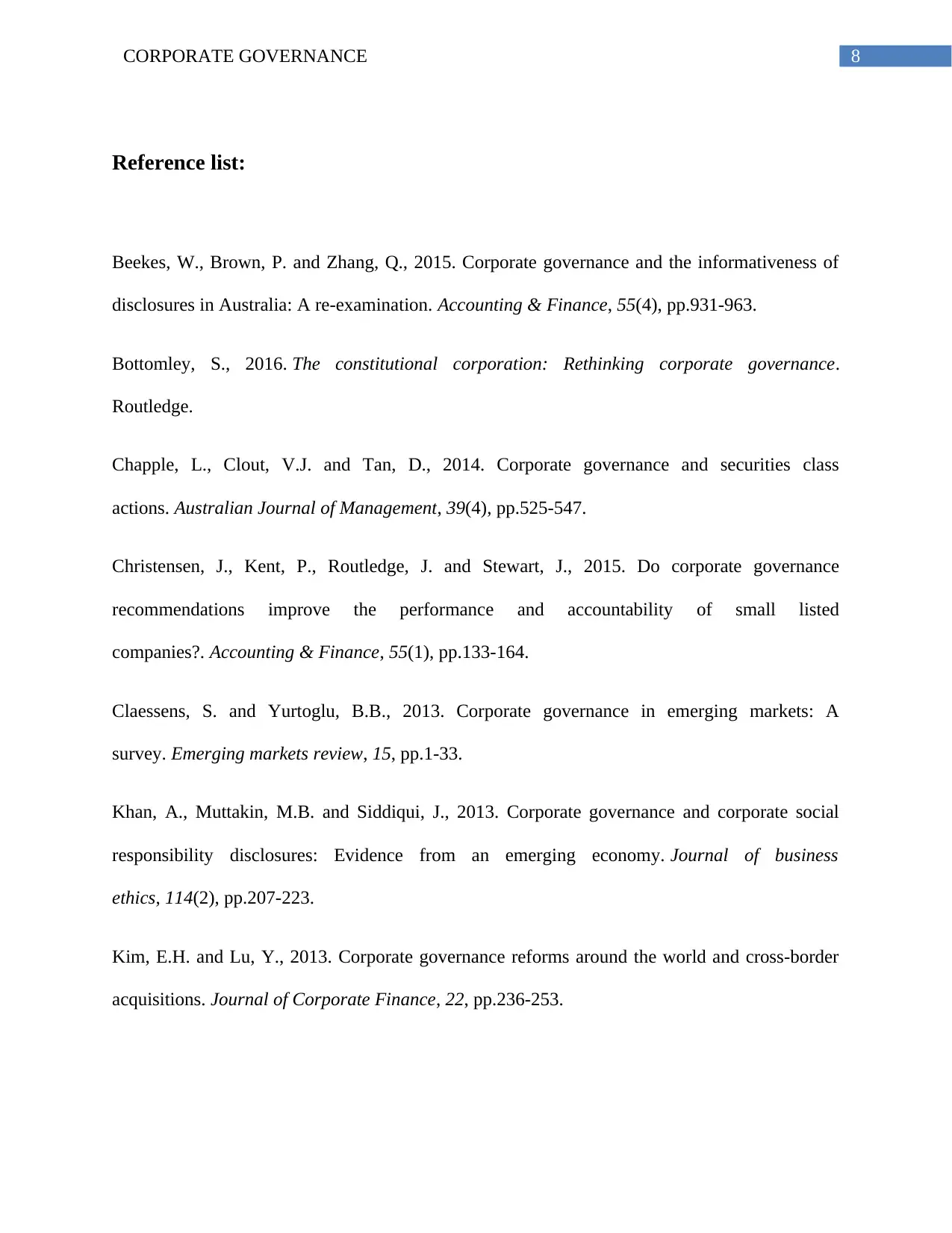
8CORPORATE GOVERNANCE
Reference list:
Beekes, W., Brown, P. and Zhang, Q., 2015. Corporate governance and the informativeness of
disclosures in Australia: A re‐examination. Accounting & Finance, 55(4), pp.931-963.
Bottomley, S., 2016. The constitutional corporation: Rethinking corporate governance.
Routledge.
Chapple, L., Clout, V.J. and Tan, D., 2014. Corporate governance and securities class
actions. Australian Journal of Management, 39(4), pp.525-547.
Christensen, J., Kent, P., Routledge, J. and Stewart, J., 2015. Do corporate governance
recommendations improve the performance and accountability of small listed
companies?. Accounting & Finance, 55(1), pp.133-164.
Claessens, S. and Yurtoglu, B.B., 2013. Corporate governance in emerging markets: A
survey. Emerging markets review, 15, pp.1-33.
Khan, A., Muttakin, M.B. and Siddiqui, J., 2013. Corporate governance and corporate social
responsibility disclosures: Evidence from an emerging economy. Journal of business
ethics, 114(2), pp.207-223.
Kim, E.H. and Lu, Y., 2013. Corporate governance reforms around the world and cross-border
acquisitions. Journal of Corporate Finance, 22, pp.236-253.
Reference list:
Beekes, W., Brown, P. and Zhang, Q., 2015. Corporate governance and the informativeness of
disclosures in Australia: A re‐examination. Accounting & Finance, 55(4), pp.931-963.
Bottomley, S., 2016. The constitutional corporation: Rethinking corporate governance.
Routledge.
Chapple, L., Clout, V.J. and Tan, D., 2014. Corporate governance and securities class
actions. Australian Journal of Management, 39(4), pp.525-547.
Christensen, J., Kent, P., Routledge, J. and Stewart, J., 2015. Do corporate governance
recommendations improve the performance and accountability of small listed
companies?. Accounting & Finance, 55(1), pp.133-164.
Claessens, S. and Yurtoglu, B.B., 2013. Corporate governance in emerging markets: A
survey. Emerging markets review, 15, pp.1-33.
Khan, A., Muttakin, M.B. and Siddiqui, J., 2013. Corporate governance and corporate social
responsibility disclosures: Evidence from an emerging economy. Journal of business
ethics, 114(2), pp.207-223.
Kim, E.H. and Lu, Y., 2013. Corporate governance reforms around the world and cross-border
acquisitions. Journal of Corporate Finance, 22, pp.236-253.
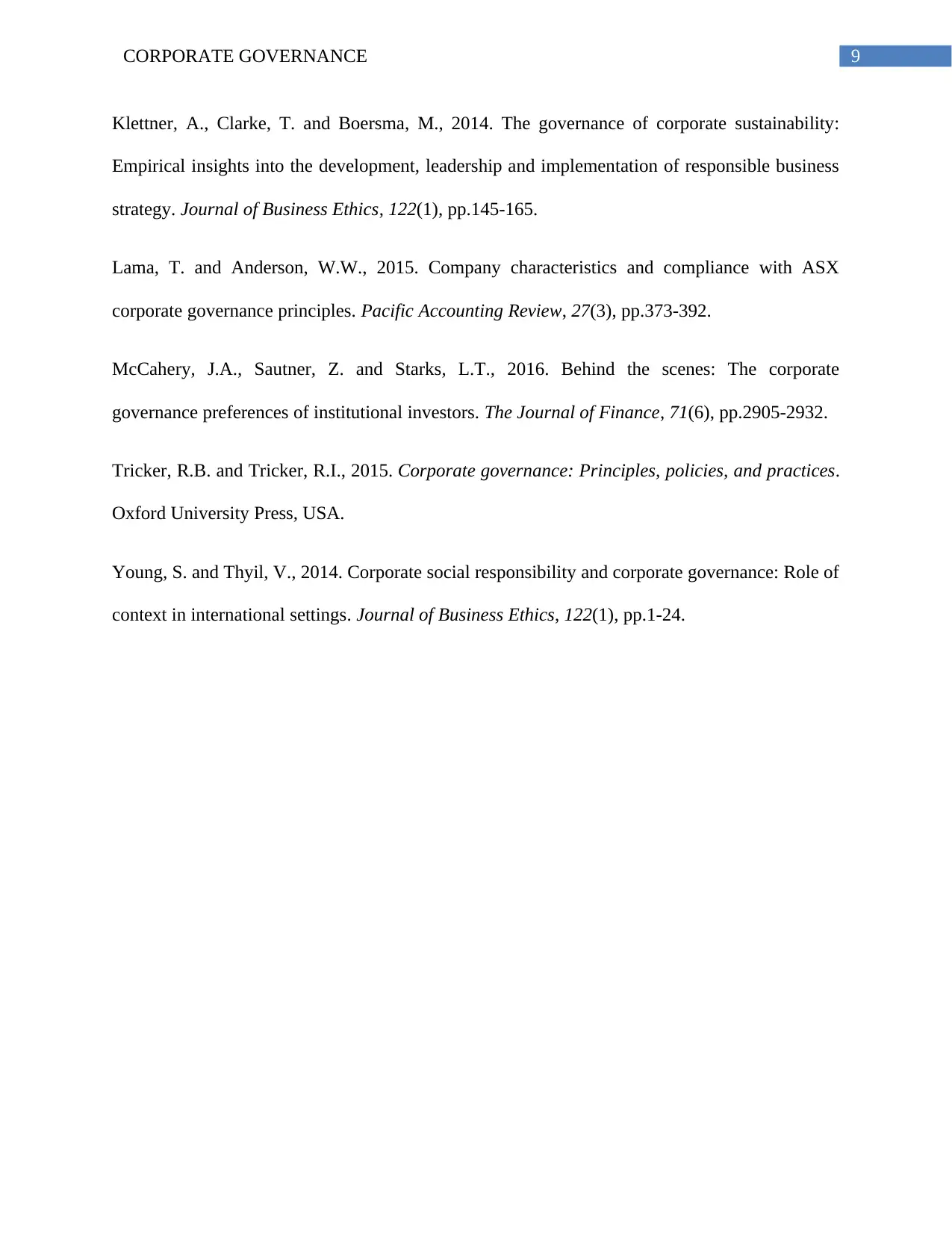
9CORPORATE GOVERNANCE
Klettner, A., Clarke, T. and Boersma, M., 2014. The governance of corporate sustainability:
Empirical insights into the development, leadership and implementation of responsible business
strategy. Journal of Business Ethics, 122(1), pp.145-165.
Lama, T. and Anderson, W.W., 2015. Company characteristics and compliance with ASX
corporate governance principles. Pacific Accounting Review, 27(3), pp.373-392.
McCahery, J.A., Sautner, Z. and Starks, L.T., 2016. Behind the scenes: The corporate
governance preferences of institutional investors. The Journal of Finance, 71(6), pp.2905-2932.
Tricker, R.B. and Tricker, R.I., 2015. Corporate governance: Principles, policies, and practices.
Oxford University Press, USA.
Young, S. and Thyil, V., 2014. Corporate social responsibility and corporate governance: Role of
context in international settings. Journal of Business Ethics, 122(1), pp.1-24.
Klettner, A., Clarke, T. and Boersma, M., 2014. The governance of corporate sustainability:
Empirical insights into the development, leadership and implementation of responsible business
strategy. Journal of Business Ethics, 122(1), pp.145-165.
Lama, T. and Anderson, W.W., 2015. Company characteristics and compliance with ASX
corporate governance principles. Pacific Accounting Review, 27(3), pp.373-392.
McCahery, J.A., Sautner, Z. and Starks, L.T., 2016. Behind the scenes: The corporate
governance preferences of institutional investors. The Journal of Finance, 71(6), pp.2905-2932.
Tricker, R.B. and Tricker, R.I., 2015. Corporate governance: Principles, policies, and practices.
Oxford University Press, USA.
Young, S. and Thyil, V., 2014. Corporate social responsibility and corporate governance: Role of
context in international settings. Journal of Business Ethics, 122(1), pp.1-24.
1 out of 10
Related Documents
Your All-in-One AI-Powered Toolkit for Academic Success.
+13062052269
info@desklib.com
Available 24*7 on WhatsApp / Email
![[object Object]](/_next/static/media/star-bottom.7253800d.svg)
Unlock your academic potential
© 2024 | Zucol Services PVT LTD | All rights reserved.





